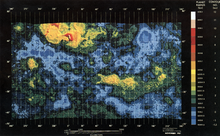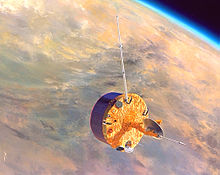Pioneer Venus


Landing or impact sites of the Pioneer-Venus 2 mission : one large and three small probes, as well as the bus (orbiter) |
Pioneer-Venus was a space research project of the United States .
prehistory
In 1962 who had US with Mariner 2 , the first spacecraft to Venus sent. This determined on the Venus has a surface temperature of about 425 ° C, excluded the life on Venus. With that, NASA's interest in Venus decreased and it focused instead on Mars . Mariner 2 was followed by the Venus probe Mariner 5 in 1967. In 1974, Mariner 10 flew past Venus on the way to its actual destination, Mercury , and photographed it for the first time.
In the meantime, with the Venera missions , the Soviet Union had taken the lead in the exploration of Venus.
mission
In the late 1960s, the US National Academy of Sciences proposed a dual mission to Venus. This proposal envisaged an orbiter that would map the entire surface with a radar and a probe that would expose several submersible capsules in the Venusian atmosphere in order to explore them to the surface. This space probe program should serve the basic research of Venus and be implemented as cheaply as possible. The program was therefore implemented as a pioneer mission, whose twist-stabilized space probes were cheaper than the 3-axis stabilized probes from other programs. The probes within the Pioneer series were initially missions no. 12 and no. 13 (see also Pioneer 10 and Pioneer 11 ), before they were renamed Pioneer-Venus 1 and 2.
Pioneer Venus consisted of two probes. Both were based on the lower part of the satellite bus used by the Intelsat IV communications satellites . However, the scientific payload of both probes was completely different:
- Pioneer Venus 1 weighed 582 kg, was 4.2 m high and had a diameter of 2.5 m. It was supposed to use its solid rocket engine to brake into a highly eccentric orbit around Venus, then map Venus with radar and analyze it while flying through the highest layers of the atmosphere in order to investigate their composition and the interactions of the high atmosphere with the solar wind.
- Pioneer Venus 2 weighed 904 kg, was around 3.0 m high and had a diameter of 2.5 m. It should enter the atmosphere unchecked and analyze it. A few days before this entry, she was supposed to set down one large and three small cone-shaped daughter probes, which were also to explore the atmosphere of Venus.
- The large daughter probe was 1.5 m in diameter and weighed 316 kg.
- The three small daughter probes each had a diameter of 0.8 m and weighed 93 kg.
- After dropping the daughter probes, Pioneer-Venus 2 still weighed 309 kg, was 1.2 m high and 2.5 m in diameter.
course
- Pioneer Venus 1 took off on May 20, 1978 at 14:13 CET with an Atlas Centaur rocket from Launch Complex 36 on Cape Canaveral into its transfer orbit to Venus. The probe entered orbit Venus on December 4, 1978. The lowest point of this orbit ran in a range between 153 and 300 km, while the highest point was constant at 66,000 km. The radar could only be used near the lowest point of the orbit to map Venus. Every time the highest point was passed, Pioneer-Venus 1 took a photo of the planet to study Venus' global weather. In June 1980 fuel was running out and orbit corrections were suspended. In the course of time orbital disruptions from the sun increased the lowest point of the orbit to an altitude of 2290 km. In 1986 the lowest point of the railway began to fall again. In 1991 the radar device was activated again to map previously unmappable areas, because the orbit inclination had also changed due to the orbit disturbances. From May 1992, the lowest point of the railroad with the last fuel reserves was kept at an altitude of 150–250 km for as long as possible. Then the fuel was exhausted and Pioneer-Venus 1 burned up on October 8, 1992 in the atmosphere of Venus.
- Pioneer Venus 2 took off on August 8, 1978 at 8:33 a.m. CET with an Atlas Centaur rocket from Launch Complex 36 on Cape Canaveral into its transfer orbit to Venus. The large daughter probe was released on November 16, 1978, followed by the three small daughter probes on November 20, 1978. The mother probe and its four daughter probes entered the atmosphere of Venus on December 9, 1978 and examined them to the surface. One of the three small daughter probes managed to survive the impact on the surface at around 35 km / h and to send data for another 67 minutes after landing. It turned out that it took a full three minutes for the dust raised by the impact to settle again.
Results
Measured against its goals, Pioneer Venus was a successful US space research project. The Pioneer-Venus 1 radar map was of poor quality (with a resolution of around 20 kilometers per pixel point, about as good as the map in a world atlas), but it was the first global map ever. Pioneer-Venus 1 also observed the changeable winds in the Venusian atmosphere over a longer period of time. Pioneer Venus 2 analyzed the composition of the atmosphere more precisely than any previous probe. The fact that the first US landing of Venus came about was just as unplanned as that the record for survival time for Venus landers went to the USA. However, 16 days later it went back to the Soviet Union to the lander of Venera 11, which with 95 minutes clearly exceeded the record of Pioneer Venus 2.
There was a follow-up project for Pioneer Venus 1 under the name Magellan .
See also
swell
- ↑ Bernd Leitenberger: Pioneer Venus Orbiter
Web links and literature
- The Pioneer Venus Mission 3-part essay by Bernd Leitenberger
- Pioneer-Venus in the NASA (English)
- Pages about Pioneer-Venus Orbiter at NASA's HEASARC (English)
- “Pioneer-Venus Project Information” from NASA's NSSDC (English)
- Pioneer Venus Orbiter at the "University of California, Los Angeles (ULCA)" (English)
- Richard O Fimmel, Lawrence Colin, Eric Burgess: Pioneering Venus: a planet unveiled. Prepared at NASA Ames Research Center 1995, ISBN 0-9645537-1-6 , NASA-SP-518, On the Internet in various resolutions at Archive.org (English)






